In interior design, glass is noticeably replacing typical interior materials such as wood and stone. This trend was made possible thanks to new refining technologies and the creativity of the glass refiners with regards to product development and marketing.
For façades, glass has long since gained status as preferred material. Refined into high-performance functional glass, the transparent material takes on various functions in the building shell. It offers protection from heat, sunlight and noise, directs light to specific areas in rooms, and – thanks to its unique transparency – facilitates light, open architectural design. In addition, glass also offers nearly unlimited design options. Glass can be transparent, translucent or opaque. It can create architectural accents through colour and individual designs and fulfil the toughest security requirements, at the same time. No other façade material offers a similar scope of design possibilities.
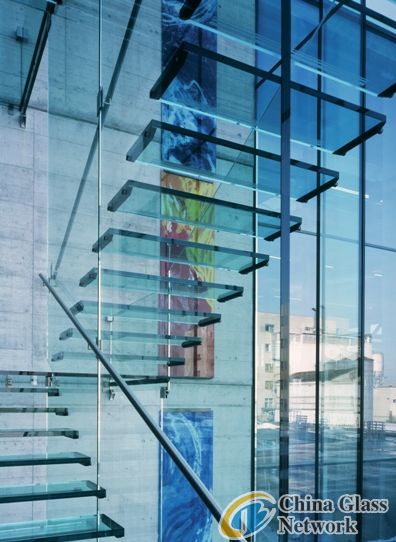
Photo 1:
Glass stairs create maximum transparency in the stairwell. This multilevel construction was designed by Glas Trösch using the Swissstep system.
Picture: Glas Trösch / Photo: Hans Ege Luzern
Drawing Interest
While the advantages of glass in façade construction have been valued for decades, the glass trend in interior design only started in the last 10 years. Two framework conditions are mainly responsible for the extraordinarily positive development of the material in the area of interior design. On the one hand, several new refining technologies have been developed recently that allow for the production of completely new glass products. On the other hand, the glass industry and the medium-sized glass refiners have developed numerous creative glass ideas on the basis of these new techniques and have used systematic marketing measures to direct interest to the innovative glass products.
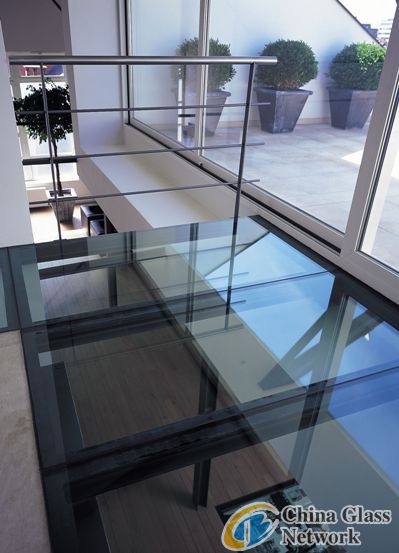
Photo 2:
Glass floors – a current trend. For this building in Antwerp, SGG Lite-Floor by Saint-Gobain was used. The walk-on laminated safety glass can be designed in pre-stressed glass, partially pre-stressed glass or a combination of both, depending on load and bearing situation.
Picture: ClimaplusSecurit-Partner / Verlinden
Attractive Business Segment
Industrial glass producers, medium-sized refiners and the glass processers in the trades sector are using various approaches to introduce architects and contractors to the unique possibilities offered by glass in interior design. Swiss Company Glas Trösch Group, for example, operates interior design centers of excellence with exclusive showrooms that present the entire scope of interior design with glass elements. Consulting company Glas Trösch Beratungs-GmbH, located in Ulm, regularly offers day-long designer workshops that focus on innovative glass ideas. The internationally active glass refiner Interpane offers a comprehensive product line for interior design. The company offers sample exhibits to customers wishing to present the topic in in-house exhibitions. These exhibitions bring to life the various applications and effects of the different refining technologies.
The Internet is used intensively. As an example for the activities of many other companies, we would like to focus on ClimaplusSecurit Group. More than 70 medium-sized refiners of Saint-Gobain glass products have joined forces in this group. On a separate Internet domain, the partner companies show what glass can do and present the entire range of glass products for interior zones. This positive development is also fuelled by the innumerable glass-processing trades operations that spark end customers’ interest in interior design using glass in online presentations and in-house exhibitions.
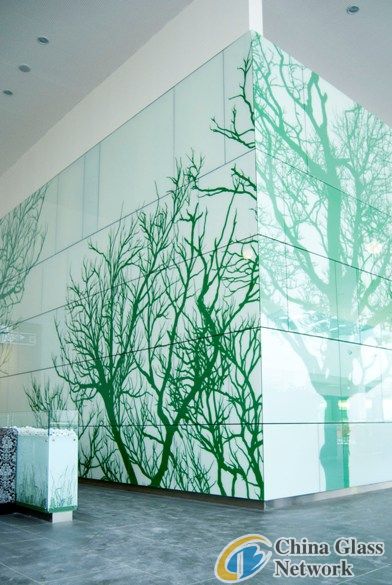
Photo 3:
Refined glass products are more and more being used also for the individual design of entire wall areas. In the Grand Mall in Varna, Bulgaria, the trees added using ceramic digital printing create a special room atmosphere.
Picture: Interpane
Successful joint Initiative
The many activities of the glass industry are supported by its suppliers. Fittings producers, foil suppliers and a plethora of other refining technology contractors continue to drive the trend towards glass through new products developed for glass applications for interior design and the corresponding advertising campaigns. The intensive and broad presentation of the topic has been bearing fruit. More and more, architects and contractors are choosing glass for the design of modern interior zones – in office buildings and private residences. An excellent overview of the currently available technologies for the production and refining of glass and the entire scope of glass and fittings products and their applications is offered at glasstec 2012, the foremost international trade fair of the glass industry, held in Düsseldorf from 23 to 26 October.
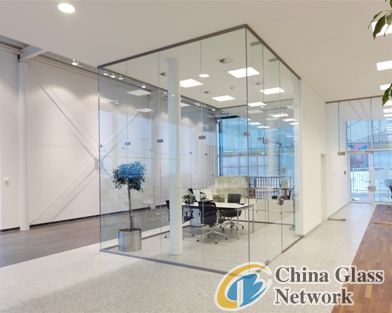
Photo 4:
Glass conference rooms emphasise the transparency and openness of companies. On request, power-driven glazing can be installed that turns opaque at the push of a button and offer a reliable privacy shield.
Picture: Glas Trösch
Innovative Technology – Building Block of Success
Without the new production technologies developed by the glass systems engineers, glass would have hardly been able to acquire its current position in interior architecture. Digital printing in particular has opened up to glass refiners completely new options for glass design. The printing process allows for nearly limitless glass designs. From simple graphic structures to large-format, all-over image presentation in top quality, everything is possible. A digital model is sufficient to print the desired motif quickly and easily onto the glass surface. The number of individualised applications is second to none.
Another part of the success story relates to new laminating technologies. The scope of materials that can be enclosed between two panes of glass includes razor-thin insertions of high-quality stone, wood veneer, fabric and metal textiles as well as organic inserts. This technology also uses digital printing. Just like glass, PVB foils can be printed with individual motifs and then be laminated. Multi-layer glass technology is specifically well-suited for the production of glass products that require a marriage between individual design and heightened safety requirements. The glass laminate permanently protects the insertions and guarantees excellent optics as well as the necessary safety against breakage. Individual designs can also be realised for multi-layer laminates, for flooring or stair treads, for example. In addition to colour accents, light effects created by LED illuminants in particular, are currently sought after.
Most interesting for the producers of individual designer multi-layer glass are new laminating procedures that do no longer require an autoclave during the lamination process. The compact systems are relatively cost-effective and offer glass-processers in the trades sector excellent opportunities to become active in the lucrative designer glass market. Laser technology is just getting ready to enter into the industrial refinement of flat glass. Not only does it offer individual surface processing of glass, but also the application of three-dimensional interior engraving. The glass surfaces remain completely intact in the process. In addition to the fairly recent technologies in glass refining, the classic refining processes such as screen printing, sandblasting and etching continue to offer numerous options to create sophisticated design glass from simple flat glass.

Photo 5:
Digital printing on glass and foils opens up nearly unlimited design possibilities. Room dividers, glass doors or shower walls can be printed with individual motifs in high resolution.
Picture: Glas Marte GmbH
Nothing seems impossible
The total of the available technologies forms the base of the manifold design options. There is the right glass product for each customer requirement, no matter how unusual, manufactured to individual specifications and exact measurements. There are hardly any limits that would cramp the creativity of designers, architects and contractors in the design of glass products. This also applies to the possible applications of these products.
Ceilings, floors, room dividers, doors, wall panels, stairs, side rails and furniture made of glass can be individually aligned with the room concepts. Glass products also find a wide area of application in bathrooms and kitchens. Shower stalls, wash stands and basins, as well as radiators made of refined glass create a sophisticated ambiance, as do glass cabinet doors, kitchen mirrors, countertops or entire kitchen fronts. Ideal for the use in conference rooms is power-driven multi-layer glass with integrated crystal foils. At the push of a button, the transparent glass changes to opaque and offers a privacy shield. Even in case of heightened security requirements, glass solutions can be used. In the form of thin tempered safety glass or laminated safety glass, the material withstands high mechanical and thermal stress.
In all areas of application, the refined glass products not only convince thanks to their attractive looks, but also due to their high level of functionality. Last but not least, easy maintenance is another argument for the use of glass in interior design over alternative materials.
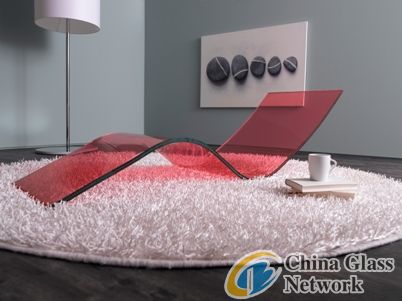
Photo 6:
By inserting laminates of coloured PVB foils, attractive glass walls and designer furniture with the specific performance features of tempered safety glass can be produced. The picture shows an exhibit by Semcoglas Company.
Picture: Semcoglas Holding GmbH
glasstec 2012 Press Contacts
Sebastian Pflügge
Brigitte Küppers (Assistant)
Ph.: +49(0)211/4560-464 or -929
Fax: +49(0)211/4560-87 464
E-mail: [email protected] or





